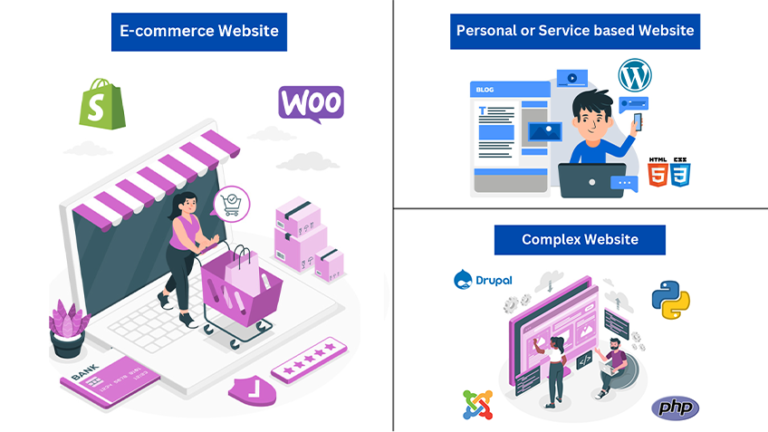If your website has been around for a while, it might be time to consider a redesign. In today’s fast-paced digital world, a website that looks outdated or doesn’t function well can harm your business. A redesign can breathe new life into your online presence, making it more appealing, user-friendly, and effective at converting visitors into customers. In this blog, we’ll explore the essential tips and best practices for successfully revamping your website.
Why Consider a Website Redesign?
Before diving into the how-to’s, it’s important to understand why a website redesign might be necessary. Here are some common reasons:
Outdated Design: Web design trends evolve quickly. A website that looked modern a few years ago might now appear outdated, which can impact your brand’s image. If your site no longer reflects your brand’s personality or looks old-fashioned, it’s time for a refresh.
Poor User Experience: User experience (UX) is critical. If your website is difficult to navigate, slow to load, or not mobile-friendly, users will likely leave and not return. A redesign can address these issues, making your site more user-centric and efficient.
Low Conversion Rates: If your website isn’t converting visitors into customers or leads as effectively as you’d like, it might be due to design flaws. A redesign can help you optimize your site for better performance, improving both engagement and conversion rates.
Planning Your Website Redesign
A successful website redesign starts with thorough planning. Here’s how to get started:
Set Clear Goals: Before you begin, define what you want to achieve with your redesign. Are you looking to improve user experience, increase conversions, or update your brand image? Having clear goals will guide your design decisions and ensure your redesign meets your business needs.
Analyze Your Current Website: Take a close look at your existing website. Identify what’s working well and what needs improvement. Consider using tools like Google Analytics to see which pages are performing best and where users are dropping off. This data will help you prioritize changes and focus on the areas that need the most attention.
Understand Your Audience: Your website should be designed with your target audience in mind. Revisit your buyer personas to ensure you’re clear on who your audience is and what they need. This will help you create a design that resonates with them and meets their expectations.
Key Elements of a Successful Redesign
Now that you’ve planned your redesign, it’s time to focus on the key elements that will make it successful.
1. Modern, Responsive Design
A modern design is crucial for making a good first impression. But it’s not just about looks—your website also needs to be responsive, meaning it should work well on all devices, including desktops, tablets, and smartphones.
Tips for Modern Design:
- Clean Layout: Use a clean, minimalistic layout with plenty of white space. This makes your content easier to read and navigate.
- Bold Typography: Choose fonts that are easy to read and fit your brand’s style. Larger, bold fonts are popular for headlines and calls to action.
- High-Quality Images: Use professional, high-quality images that are relevant to your content. Avoid stock photos that look generic or overused.
2. Improved Site Performance
A website that loads quickly and performs smoothly is essential for keeping users engaged. Slow load times can frustrate visitors and lead to higher bounce rates.
Tips for Boosting Performance:
- Optimize Images: Compress images to reduce file size without sacrificing quality.
- Minimize Code: Clean up your website’s code by removing unnecessary elements and minimizing CSS and JavaScript files.
- Leverage Browser Caching: Enable browser caching to reduce load times for returning visitors.
3. Enhanced User Experience (UX)
User experience should be at the forefront of your redesign. A site that’s easy to use will keep visitors on your page longer and encourage them to take action.
Tips for Enhancing UX:
- Intuitive Navigation: Make sure your navigation is simple and logical. Use clear labels and a consistent structure across all pages.
- Accessible Design: Ensure your site is accessible to all users, including those with disabilities. This includes using alt text for images, providing keyboard navigation options, and ensuring sufficient color contrast.
- Engaging Content: Create content that is not only informative but also engaging. Use visuals, videos, and interactive elements to keep users interested.
4. Strong Calls to Action (CTAs)
Your website should guide visitors toward taking specific actions, whether it’s making a purchase, signing up for a newsletter, or contacting your team. Effective CTAs are crucial for achieving this.
Tips for Effective CTAs:
- Action-Oriented Language: Use clear, compelling language that tells users exactly what to do, like “Get Started,” “Sign Up Today,” or “Contact Us Now.”
- Strategic Placement: Place CTAs where they’re most likely to be seen, such as at the top of the page, within the content, or at the end of a blog post.
- Contrasting Colors: Make your CTAs stand out by using colors that contrast with the rest of your design.
Launching and Testing Your Redesigned Website
Once your redesign is complete, it’s time to launch and test your new site.
Pre-Launch Testing: Before going live, thoroughly test your website. Check for broken links, test forms, and ensure everything works as intended across different devices and browsers. Make sure all content is up-to-date and that your SEO settings are properly configured.
Post-Launch Monitoring: After launching your new website, continue to monitor its performance. Use analytics tools to track user behavior, page load times, and conversion rates. This data will help you identify any issues and make necessary adjustments.
Gather Feedback: Ask for feedback from users, employees, and stakeholders. This can provide valuable insights into how the redesign is being received and highlight areas for further improvement.
Is Your Website in Need of a Makeover?
Your website is your digital storefront. Make sure it leaves a lasting impression! Our expert team specializes in transforming outdated websites into modern, user-friendly experiences that captivate and convert.
Feel free to connect with me – https://sahilkaul.com/
Hire me – https://www.upwork.com/freelancers/sahilkaul1996
How do I know if my website needs a redesign?
Your website might need a redesign if it looks outdated, isn’t mobile-friendly, loads slowly, or isn’t converting visitors into customers as effectively as you’d like. Additionally, if your business has evolved and your website no longer reflects your current brand or services, a redesign can help align your online presence with your business goals.
How long does a website redesign typically take?
The timeline for a website redesign can vary depending on the complexity of the project. A basic redesign might take a few weeks, while a more comprehensive overhaul with custom features could take several months. The process typically involves planning, design, development, testing, and launching phases.
What should I prioritize during a website redesign?
When redesigning your website, prioritize improving user experience (UX), ensuring mobile responsiveness, enhancing site performance (such as faster load times), and updating your design to reflect modern trends and your brand identity. It’s also important to focus on clear navigation, strong calls to action (CTAs), and optimizing the site for conversions.
How can I ensure my redesigned website is user-friendly?
To create a user-friendly website, start by understanding your audience’s needs and behaviors. Use intuitive navigation, ensure the site is mobile-responsive, and maintain fast loading times. Conduct user testing during the redesign process to gather feedback and make necessary adjustments. Accessibility features, such as alt text for images and keyboard navigation, also contribute to a more inclusive user experience.
Will a website redesign affect my SEO rankings?
A website redesign can affect your SEO rankings, either positively or negatively. To avoid losing rankings, ensure that all current URLs are properly redirected to new URLs if they change, maintain on-page SEO elements (like meta tags and keywords), and keep the site structure intact. A well-executed redesign can actually improve your SEO by enhancing site speed, mobile friendliness, and overall user experience.
What is the cost of a website redesign?
The cost of a website redesign varies based on the complexity of the project, the features you want to include, and whether you’re hiring a professional developer or doing it yourself. Basic redesigns can start at a few thousand dollars, while more complex projects with custom features and integrations can cost significantly more. It’s important to set a budget and get detailed quotes before starting the redesign process.
If you're looking for any services regarding Digital Marketing or Website Developement, Please Contact now.






Leave a Comment